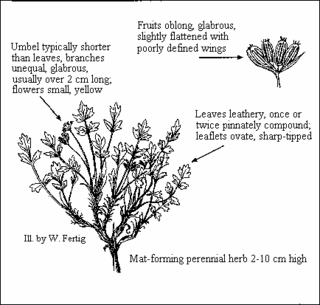
Ptilimnium is a group of plants in the family Apiaceae described as a genus in 1819. The common name is mock bishopweed or mock bishop's weed. It is endemic to the United States, primarily in the Southeast, the Lower Mississippi Valley, and the Lower Great Plains.

Pachycereus is a genus of large cacti native to Central America and Mexico. They form large shrubs or small trees up to 15 m tall, with stout stems up to 1 m in diameter. Pachycereus comes from the ancient Greek παχύς (pachys) meaning "thick" and the Latin cereus meaning "torch".
Echinomastus was a formerly recognized genus of cacti. As of February 2024, it is accepted as a synonym of Sclerocactus. Species formerly placed in the genus are native to the southwestern United States and Mexico.

Aletes has been regarded a genus of flowering plants in the family Apiaceae, all of which are endemic to North America. As of December 2022, Plants of the World Online regarded Aletes as a synonym of Cymopterus, while GRIN Taxonomy regarded it as a possible synonym of that genus.

Trillium vaseyi is a species of flowering plant in the family Melanthiaceae. It is a spring-flowering perennial plant found only in the southeastern United States. The specific epithet vaseyi honors the American plant collector George Richard Vasey, not to be confused with his father George S. Vasey. The species is commonly called Vasey's Trillium. It is also known as the sweet wakerobin, sweet trillium, or sweet beth.

Lilaeopsis is a genus of aquatic and riparian flowering plants in the umbel family Apiaceae, which earns them the common name 'water umbels'. Lilaeopsis are primarily found along the Pacific coast of the Americas, from southern Alaska to Tierra del Fuego and southern Patagonia, as well as the Falkland Islands and some Caribbean and Oceanic islands. One species, L. mauritiana, is found on the Indian Ocean islands of Madagascar and Mauritius.

George S. Vasey was an English-born American physician and botanist. He practiced medicine in Illinois for nearly two decades. He was appointed Chief Botanist at the United States Department of Agriculture in 1872, a position he held for the remainder of his life. His greatest achievement was the building up of the United States National Herbarium.

Lomatium donnellii is a perennial herb of the family Apiaceae, in the Western United States.

Salvia vaseyi, the scallop-leaf sage, bristle sage or wand sage, is a perennial native to the western Colorado Desert. The specific epithet vaseyi honors the American plant collector George Richard Vasey, not to be confused with his father George S. Vasey.
Aletes humilis is a species of flowering plant in the carrot family known by the common names Colorado aletes and Larimer aletes. It is native to Colorado in the United States; it is also known from Wyoming, but there are no recent collections there.

Rhododendron vaseyi, the pinkshell azalea, is a species of flowering plant in the heath family Ericaceae. It is endemic to the Appalachian highlands of North Carolina. The specific epithet vaseyi honors the American plant collector George Richard Vasey and his father Dr. George Vasey, Chief Botanist at the United States Department of Agriculture from 1872 to 1893. The species is sometimes referred to as the Vasey Rhododendron.

Lomatium plummerae is a formerly recognized species of plant in the family Apiaceae. When recognized, it was subdivided into a number of subspecies and varieties. As of August 2021, Plants of the World Online considers the species itself and the variety helleri to be synonyms of Lomatium donnellii, and the varieties austiniae and sonnei as synonyms of Lomatium austiniae, whereas the Jepson eFlora considers the species and the varieties austiniae and sonnei to be synonyms of Lomatium donnellii.
Cylindropuntia calmalliana is a species of flowering plant in the family Cactaceae, native to Mexico. It was first described in 1896 by John Merle Coulter, as Opuntia calmalliana.

Chrysothamnus vaseyi is a species of flowering plant in tribe Astereae in the daisy family Asteraceae. It is native to the Southwestern United States. The specific epithet vaseyi honors the American botanist George S. Vasey. The species is commonly called Vasey's rabbitbrush.
Hymenoxys vaseyi is a species of flowering plant in the daisy family Asteraceae. It is native to the Southwestern United States. The specific epithet vaseyi honors the American plant collector George Richard Vasey who made extensive collections in the region in 1880 and 1881. The species is commonly called Vasey's rubberweed.
Rhodosciadium is a genus of flowering plants belonging to the family Apiaceae.
Neonelsonia is a monotypic genus of flowering plants belonging to the family Apiaceae. It just contains one species, Neonelsonia acuminata, native to southern Mexico, Colombia, Costa Rica, Ecuador, Guatemala, Panamá, Peru and Venezuela. It is part of the tribe Selineae.

Lomatium orientale, commonly known as salt-and-pepper, eastern cous, eastern desert-parsley, eastern lomatium, white-flowered desert-parsley, oriental desert parsley or Northern Idaho biscuitroot, is a small spring blooming ephemeral plant. It grows in open habitats from the plains to foothills in western North America. It is known as one of the earliest blooming native flowers in its habitat. The species name, "orientale", is botanical Latin meaning "eastern".
George Richard Vasey (1853–1921) was an American plant collector who collected in at least eight U.S. states including California, North Carolina, and Washington. He was the son of Dr. George S. Vasey, a physician and botanist. The botanical activities of father and son overlapped in time, so the two men are often confused.












